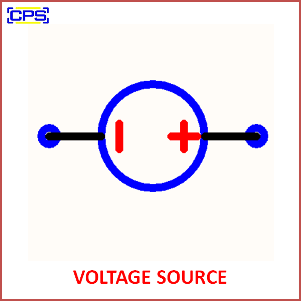A Voltage Source is an electrical component or system that provides a constant or variable voltage to a circuit or load. It supplies the necessary potential difference (voltage) that drives the flow of current in an electrical circuit. Voltage sources can be either AC (Alternating Current) or DC (Direct Current), depending on the nature of the voltage they generate.

Key Features of a Voltage Source:
- Voltage Supply:
- A voltage source provides the electrical potential difference (measured in volts) between two points in a circuit, which is essential for current flow.
- Constant or Variable Voltage:
- A Constant Voltage Source maintains a fixed voltage regardless of the current drawn by the load (e.g., a battery or regulated power supply).
- A Variable Voltage Source allows the voltage to be adjusted according to the needs of the circuit (e.g., a variable power supply).
- Types of Voltage Sources:
- DC Voltage Source: Provides direct current (DC) at a constant or varying voltage. Examples include batteries, DC power supplies, and solar cells.
- AC Voltage Source: Provides alternating current (AC) voltage that fluctuates sinusoidally or in a non-sinusoidal form, such as the electrical grid or AC power supplies.
- Ideal vs. Real Voltage Source:
- Ideal Voltage Source: In an idealized situation, a voltage source is assumed to provide a constant voltage regardless of the amount of current it delivers, and its internal resistance is zero.
- Real Voltage Source: In practice, a real voltage source has some internal resistance, and the voltage may drop if the current exceeds the source’s capacity.
Working Principle:
- A voltage source creates a potential difference between two points. When connected to a circuit, this potential difference drives current through the circuit according to Ohm’s Law: V=IRV = IRV=IR Where:
- VVV is the voltage provided by the source,
- III is the current flowing through the circuit,
- RRR is the resistance of the circuit.
The source maintains a constant voltage between its terminals, and the current flow is determined by the impedance or resistance in the connected circuit.
Applications of Voltage Sources:
- Power Supply for Circuits:
- Voltage sources provide the power required for devices and electronic circuits to function.
- Signal Generation:
- Used in signal generators to provide a known voltage level for testing and calibration of equipment.
- Battery-Powered Devices:
- Batteries act as voltage sources in portable electronics, such as mobile phones, laptops, and remote control devices.
- Power Distribution:
- In power grids, voltage sources such as generators and transformers provide AC voltage to homes, industries, and businesses.
- Voltage Regulation:
- Used in regulated power supplies to maintain a stable output voltage despite changes in the load.
Advantages:
- Powering Circuits: Voltage sources are essential for powering electronic devices and providing consistent voltage for circuits.
- Controlled Output: Some voltage sources allow precise control of the voltage, especially variable sources, which are useful in testing and calibration.
- Versatility: Voltage sources are used in various fields, from small electronics to large-scale power generation.
Disadvantages:
- Internal Resistance: Real voltage sources have some internal resistance, which can limit the maximum current they can supply.
- Finite Capacity: Every voltage source has a limit to how much current it can supply before it can no longer maintain the required voltage.
- Dependence on Power Supply: If the source relies on external power (such as batteries), its operation can be limited by the energy storage or supply capacity.
